| Article ID | Journal | Published Year | Pages | File Type |
|---|---|---|---|---|
| 1093025 | Women's Health Issues | 2014 | 8 Pages |
BackgroundRising rates of labor induction and cesarean delivery, especially when used without a medical reason, have generated concern among clinicians, women, and policymakers. Whether employment status affects pregnant women's childbirth-related care is not known. We estimated the relationship between prenatal employment and obstetric procedures, distinguishing whether women reported that the induction or cesarean was performed for medical reasons.MethodsUsing data from a nationally representative sample of women who gave birth in U.S. hospitals (n = 1,573), we used propensity score matching to reduce potential bias from nonrandom selection into employment. Outcomes were cesarean delivery and labor induction, with and without a self-reported medical reason. Exposure was prenatal employment status (full-time employment, not employed). We conducted separate analyses for unmatched and matched cohorts using multivariable regression models.FindingsThere were no differences in labor induction based on employment status. In unmatched analyses, employed women had higher odds of cesarean delivery overall (adjusted odds ratio [AOR], 1.45; p = .046) and cesarean delivery without medical reason (AOR, 1.94; p = .024). Adding an interaction term between employment and college education revealed no effects on cesarean delivery without medical reason. There were no differences in cesarean delivery by employment status in the propensity score–matched analysis.ConclusionsFull-time prenatal employment is associated with higher odds of cesarean delivery, but this association was not explained by socioeconomic status and no longer existed after accounting for sociodemographic differences by matching women employed full time with similar women not employed during pregnancy.
